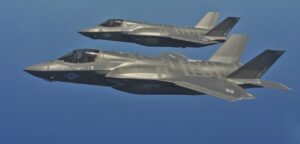
In this article, one of the Air Force’s own, longtime Breaking Defense contributor Lt. Col. Dan Ward, runs the numbers on his service’s plan to scrap the beloved A-10 Warthog and – now that Congress has thoroughly rejected the idea – suggests an alternative: a modest trim to the massive F-35 program might just save the entire A-10 fleet. – the editors.
In February 2014, Secretary of Defense Hagel briefed that retiring the A-10 fleet would save $3.5 billion over five years. That equals a savings of $700 million per year, not exactly chump change. A few months later, in April, the Air Force Chief of Staff, Gen. Mark Welsh, actually bumped the estimate up by exactly $700 million, to $4.2 billion. This means either the A-10’s annual operating expenses went up by 20% to $840 million per year, or the new savings is calculated over six years instead of five. Either way, the intended message was unambiguous: Air Force leadership did some math and made a logical decision. Retiring the A-10 fleet will save a lot of money, and these days saving money is a necessity, not an option.
But in June, the House of Representatives voted to prevent the Air Force from retiring the Warthog, leading Air Force Secretary Deborah James to ask where they want to find the money instead.
It’s a great question and one worth answering. Are there other, perhaps better ways to come up with $4.2 billion in savings? Where else could the Air Force look? One alternative is the Joint Strike Fighter, often described as the most expensive weapons system in history. Let’s do a little math here – but don’t worry, I’ll keep it as painless as possible.

Suppose one were to trim $4.2 billion from the JSF program. What sort of impact would that have? According to the Government Accountability Office, acquisition funding for the Joint Strike Fighter averages “$12.6 billion annually through 2037,” and “total U.S. investment is nearing $400 billion to develop and procure 2,457 aircraft through 2037.” It turns out $4.2 billion is approximately one percent of the total $400 billion JSF investment, which seems like a tolerable reduction.
Since we need the savings fairly soon, we can’t actually spread them evenly over the entire life of the F-35 program. If we want to save the same $4.2 billion over the next five years, to match the foregone A-10 savings, then, in terms of annual spending, reducing JSF’s annual $12.6 billion by $840 million is close to 6% per year, That is obviously more painful than a single percentage cut but hardly unheard of and unlikely to be a program killer. (It may be interesting to note that according to the Brewer’s Association, the US spends approximately $96 billion each year on beer.)
Of course, the issue at hand is national defense, not just budgeting, so we need to consider the security loss as well as the financial benefit: How many fewer F-35s would we end up with if we reduced spending by $4.2 billion? This is a harder question to answer than it may seem, partly because the JSF comes in three variants, each of which has its own price tag, and partly because it is so difficult to nail down a precise cost for any of the models.
The Pentagon’s official target was to reduce “flyaway” cost – which does not count research, development, or some important components – to a mere $83.4 to $108.1 million , depending on the variant. According to the more comprehensive figure in the latest Selected Acquisition Reports, the “program acquisition unit cost” of the average F-35 – counting R&D and the engine – is $134.5 million. However, in a piece for Time magazine, JSF arch-critic Winslow Wheeler calculated the true cost for the cheapest model, the Air Force F-35A, as closer to $188.5 million each, while the B and C models will set the military back approximately $277.9 million apiece, on average. A subsequent update by Wheeler calculated a price tag of $337 million for the Navy’s F-35C. It’s not clear that any of these numbers are absolutely correct, but together they can help us scope out the options.
Using the smallest of these price tags, the $83.4 million, then, in order to save a total of $4.2 billion, the Pentagon would have to forego fifty aircraft, which is approximately two percent of the total fleet. That seems like a tolerable margin. Using Wheeler’s figures of $188.5 million per aircraft, we could save the same amount by purchasing just 22.3 fewer JSF’s. This is less than a one percent reduction in the fleet. If you just cut the carrier version – which the Navy is ambivalent about anyway – the larger $277.9 million price for an F-35C translates to just 15 fewer fighters, roughly half a percent of the fleet. Or, we could use the average estimated cost of $200 million apiece, which means a decrease of 21 jets, still considerably less than one percent. Finally, at $337 million per air craft means we could save $4.2 billion by foregoing 12.4 Navy aircraft. The table below summarizes the specific calculations.
| Price per JSF Aircraft ($M) | # Aircraft for $4.2B | Percentage of Total JSF Fleet |
| $ 83.40 | 50.4 | 2.05% |
| $188.50 | 22.3 | 0.91% |
| $200.00 | 21.0 | 0.85% |
| $277.90 | 15.1 | 0.62% |
| $337.00 | 12.4 | 0.5% |
As a point of comparison, there are 326 aircraft in the A-10 fleet, and the Air Force would have to get rid of all of them to save $4.2 billion. One might be forgiven for asking which alternative leads to a better security posture: getting rid of hundreds of A-10s now or forgoing tens of F-35s in the future?
To be sure, there is more math to be done and more factors to include. Decisions about which aircraft to keep and which to get rid of are not purely military in nature. They are also economic, political, and geo-political. But since the primary justification for scrapping the A-10 was to save $4.2 billion, and since we are looking for other ways to save an equivalent amount, it is worth considering the other options on the table. The good news is that these alternatives not only exist, they also could take a smaller bite out of the overall defense structure.
Dan Ward is a Lieutenant Colonel in the US Air Force, currently stationed at Hanscom Air Force Base. He is the author of FIRE: How Fast, Inexpensive, Restrained, and Elegant Methods Ignite Innovation, published by HarperBusiness. The views expressed in this article are solely those of the author and do not reflect the official policy or position of the U.S. Air Force or Department of Defense.
Missile Defense Agency’s new long-range radar steps toward full deployment
“The LRDR completed a Space Domain Awareness (SDA) data collect event in January 2024 that proved the SDA capability, and the U.S. Space Force and MDA are in the process of formally declaring LRDR ready for SDA early use in April 2024,” according to MDA Director Lt. Gen. Heath Collins.


























